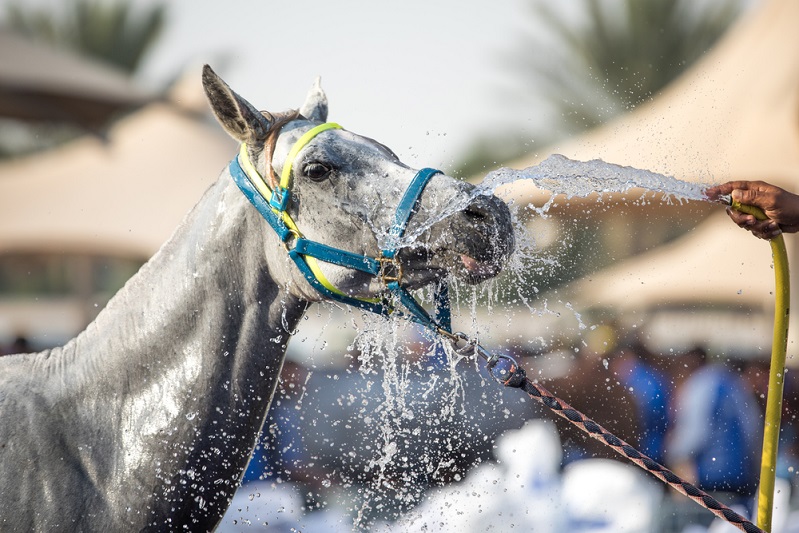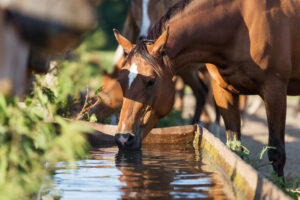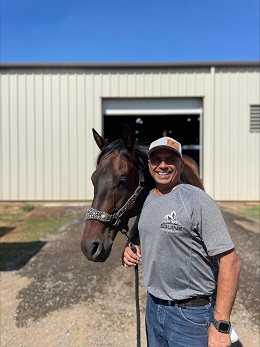If you own a horse, you’re likely aware of how much they sweat. Whether they’re galloping across a field, riding in a trailer, or just standing in the sun, horses produce gallons of sweat every day. But why do performance horses perspire so much? And is your horse sweating too much—or not enough?
Horse sweat serves just the same purpose as human sweating: It regulates body temperature through evaporation.1
Sweating is a natural and essential process, but too much or too little can cause some issues. Just like humans, performance horses can suffer from dehydration, electrolyte imbalance, skin irritation caused by heavy sweat, and overheating caused by lack of sweat. But don’t sweat it—we’re going to cover everything to know about equine perspiration, including how to recognize normal and abnormal horse sweating as well as how to handle your horse’s hydration needs.
How Horses Sweat
As a horse lover, you know people and horses have a lot of things in common. But you might not have realized that sweat is one of our more unique similarities. Believe it or not, primates and horses are the only animals that rely on sweating as their main cooling strategy.1
Sweat works the same way for both people and horses, by causing a cooling effect when it evaporates from the skin. However, horse sweat also has some key differences from human perspiration:
- Horses lather up – In times of stress or over-exertion, you may have seen your horse produce a foamy, white sweat.2 This is known as lather or soap, and it happens because of a protein in horse sweat called latherin that foams like detergent. Luckily, humans don’t make this protein, or job interviews would be even more stressful.
- Horses have different sweat glands – In horses, sweat is produced by apocrine glands. Humans sweat mostly through eccrine glands.3 Apocrine glands produce sweat that contains less protein and more electrolytes, while eccrine glands secrete more protein and fewer electrolytes.4 This makes electrolyte replacement even more important for horses after intense exercise.
- Horses sweat more – A horse can produce up to two times more sweat per square inch of skin than you do. Even in mild weather, horses lose up to 2 gallons of fluids per hour, and up to 2.5 gallons per hour in warmer temperatures.5 Some horses sweat even more, up to 4 gallons per hour during moderate exercise.6
Clearly, it’s normal for horses to produce a lot of perspiration. So how do you know if your horse is sweating normally? We’ll cover that next.

Signs of Normal and Abnormal Sweating
Sweating is usually a good thing, but excessive sweating can cause dehydration. It can also indicate an underlying problem such as fever, pain, or illnesses like equine influenza, laminitis, or Cushing’s disease.
On the other hand, lack of sweating is also a serious problem in horses that can easily lead to heat stroke.
A horse that’s sweating normally will have a lightly moist, shiny coat, especially under the saddle pad. If it’s exercising a bit harder, sweat will spread onto the neck, chest, and legs. Even if it’s tired and sweating heavily, a healthy horse will still have a good appetite and thirst.
Lack of Sweat
In most cases, too little sweat is a bigger concern than excess sweat. If a horse isn’t sweating as much as it should—or isn’t sweating at all—it could be suffering from a condition called anhidrosis.
The cause of anhidrosis isn’t fully understood, but there are some signs to watch for, such as:7
- Little to no sweat, even after exercise
- Lethargy in warm weather
- Rapid breathing and heart rate
- Elevated body temperature, even at rest or after short exercise
- Thinning coat
If your horse is anhidrotic, consult with your veterinarian for guidance. Anhidrotic horses need extra care in hot weather and during exercise. Avoid exercising in the middle of the day—go for morning or evening rides instead. After exercising, use fans and cool water to help with cool-down. Watch closely to make sure your horse’s breathing and body temperature return to normal relatively quickly.
Excessive Sweating
It can be difficult to tell if a horse is sweating more than it should be, but you can get a good idea by comparing it to other horses nearby. If your horse is sweating heavily when other horses in the same conditions aren’t, it could be a sign of a problem.
Ask yourself if:
- Your horse is exercising too hard for its fitness level
- Your horse has had time to acclimate to a change in climate (for example, if you’ve traveled for a show, or your area is experiencing a heatwave)
- Your horse is suffering from stress or fear (such as a long trailer ride)
If your horse does seem to be sweating excessively, take a break from exercising and assess for signs of dangerous heat stress.
Signs of Heat Stress
Whether your horse is sweating heavily or not sweating at all, here are some warning signals that they are in danger of overheating:8
- Heavy breathing or panting
- Lethargy, depression, or exhaustion
- Body temperature that stays high even during rest
- Uninterested in food or cool water
If your horse seems to be overheating, stop exercising immediately and head to a shady area to rest. Monitor the horse closely by checking these signs:
- Body temperature – At rest, your horse’s body temperature should be between 99 and 100 degrees. When exercising, a temperature of up to 106 degrees is normal, but should fall quickly. If your horse’s temperature is staying in the 106-110 range, they’re in danger of heat stroke. This can happen in humid weather when sweating isn’t effective, or in anhidrosis.
- Attitude – Check your horse’s behavior and body language. Are they standing normally with relaxed muscles? Do they seem alert and responsive? Are they interested in food and cold water? If so, it’s a good sign they’re recovering and are not in danger of heat stroke.
- Hydration – You can perform a quick, simple test to check your horse’s hydration level any time you’re concerned. Simply pinch a fold of skin on the neck, at the high point of the shoulder, and low on the shoulder. The skin should quickly spring back into place. In a dehydrated horse, the skin fold will stay tented for a few seconds, then slowly sink back.8 Do this test regularly when your horse is well-hydrated so you know what it should look like normally.
If your horse doesn’t seem to be cooling down or seems dazed or lethargic, seek veterinary assistance.
 How to Manage Sweat and Hydration
How to Manage Sweat and Hydration
When horses sweat, they lose water and electrolytes (minerals that help with bodily functions). And since horses sweat a lot, they can become dehydrated and suffer from electrolyte imbalances easily.
It’s not always easy to tell how much moisture your horse has lost over the course of a day—horse sweat evaporates quickly in hot, dry weather. Be alert to the possibility of dehydration any time the weather is warm, or your horse is working hard, even if you don’t see excessive sweat.
Whenever your horse breaks a sweat, make sure they stay hydrated, clean, and comfortable with these tips:
- Lead a horse to water – You may not be able to make your horse drink, but you can encourage it. Be sure to provide access to fresh, clean water at all times. Horses drink at least 6 gallons of water a day in cool weather, and working horses may need up to 18 gallons per day or more in hot weather.9 Clean troughs at least every two weeks, and wash stall buckets daily.
- Consider electrolyte supplements – Electrolyte supplements aren’t always necessary, because horses obtain most of these minerals from good-quality food and forage. However, if your horse has sweated heavily (all over the neck and chest, not just under the saddle), a dose of electrolytes is a good idea. Electrolyte supplements don’t just replenish minerals lost through sweat, but they can also help stimulate thirst. They are available as either oral pastes or powders that can be top-dressed on grain or added to water.
- Provide cool-down assistance – If your horse is having trouble cooling off due to humid weather or anhidrosis, you can use cold water and fans to provide evaporative cooling. Hose your horse down, or use a sponge to give a cool horse bath using a cooling liniment. Work slowly to avoid shocking hot muscles with sudden cold, which can cause cramping. If the weather is so humid that water isn’t evaporating, use a sweat scraper to remove the moisture and continue bathing until the skin has cooled.
- Clean after sweating – Sweat that isn’t cleaned off properly can irritate the skin and cause problems like itching, flaking, hair loss, rain rot, and other skin conditions. Use a gentle equine shampoo that’s designed to clean without stripping skin oils. Always rinse thoroughly to remove the best horse shampoo residue. In cool weather or evenings, be sure your horse is in a warm area after bathing to avoid becoming chilled while air drying.
Keep Your Cool (And Your Horse’s, Too) with Vetericyn
Sweating is essential for keeping your horse cool, comfortable, and ready to ride. However, sweating too much or too little can cause some problems, so be sure to monitor your horse carefully in warm weather and during intense exercise.
To keep your horse’s skin clean and healthy after a good heavy sweat, add Vetericyn to your equine care routine.
Our equine skin care products are designed for a horse’s sensitive skin, with hypoallergenic formulas that cleanse and moisturize without disrupting pH balance. So don’t break a sweat over equine perspiration—choose Vetericyn and keep your horse in the winner’s circle.
 Reviewed by Solomon Benarroch, Veterinarian
Reviewed by Solomon Benarroch, Veterinarian
Solomon Benarroch DVM has been a practicing veterinarian for over 30 years. His primary focus has been in equine soundness and performance sports medicine. Originally from Winnipeg, Canada he attended college at the Western College of Veterinarian Medicine. And completed an internship at the University of Minnesota. He is the father of three kids and when he isn’t working (which is rare), he enjoys traveling, cooking, and spending time with friends and family.
Sources:
- Veterinary Dermatology. Equine sweating and anhidrosis Part 1–equine sweating. https://pubmed.ncbi.nlm.nih.gov/17083570/
- Horse Side Vet Guide. Sweating excessively. https://horsesidevetguide.com/drv/Observation/461/sweating-excessively/
- Veterinary Clinics of North America: Equine Practice. Sweating. Fluid and ion losses and replacement. https://pubmed.ncbi.nlm.nih.gov/9561689/
- Kentucky Equine Research. Watery or lathered: Differences in horse sweat. https://ker.com/equinews/watery-lathered-differences-horse-sweat
- Iowa State University Equine Extension. Electrolytes and the exercising horse. https://www.extension.iastate.edu/equine/blog/dr-peggy-m-auwerda/electrolytes-and-exercising-horse
- The Horse. New method for scoring sweat losses in horses proposed. https://thehorse.com/115927/new-method-for-scoring-sweat-losses-in-horses-proposed/
- American Association of Equine Practitioners. Should I Sweat It? (Anhidrosis in Horses). https://aaep.org/horsehealth/should-i-sweat-it-anhidrosis-horses
- Practical Horseman. The scoop on horse sweat. https://practicalhorsemanmag.com/health-archive/scoop_on_sweat_032310-11484/
- American Association of Equine Practitioners. Cool, clear water. https://aaep.org/horsehealth/cool-clear-water